Tremolo is one of the oldest effects in music history. Some even believe that it originated in ancient times. This might be true, since first tremolos were created using bow instruments, which were present even in 900 A.D. A long time has passed after the first tremolo-like notes and the means of creating them have changed drastically. In a more modern era, tremolos were produced with the help of amplifiers. That was until ‘60s brought the abundance of technological discoveries, including effects pedals. Nowadays, creating the desired tremolo effects is easier than ever-your perfect tone is delivered right at your feet. The only thing left is choosing the best tremolo pedal. This article will assist you in that process and, hopefully, after reading it, you will know what to purchase. Good look my friend on your way to perfection!
Top 10 Best Tremolo Pedals
| Image | Amplifier Model | ||
|---|---|---|---|
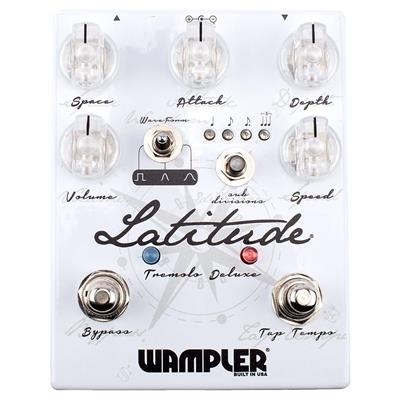 | Wampler Latitude Tremolo Deluxe Guitar Effects Pedal |  (5 / 5) (5 / 5) | Check on Amazon |
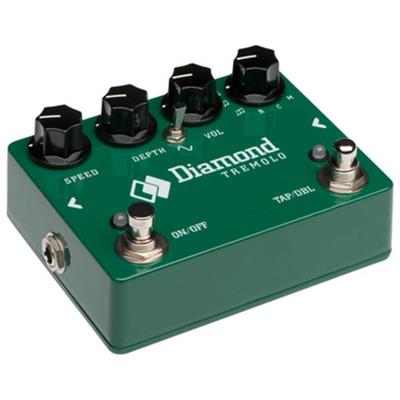 | Diamond Pedals Tremolo |  (4.9 / 5) (4.9 / 5) | Check on Amazon |
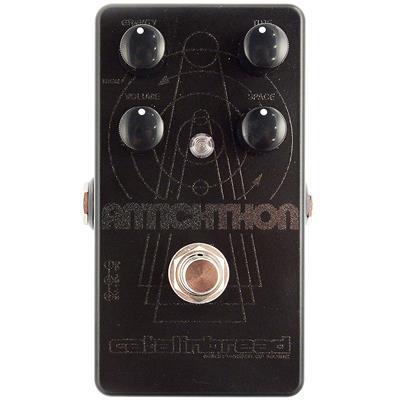 | Catalinbread Antichthon Tone-Generating Fuzz Tremolo Pedal |  (4.9 / 5) (4.9 / 5) | Check on Amazon |
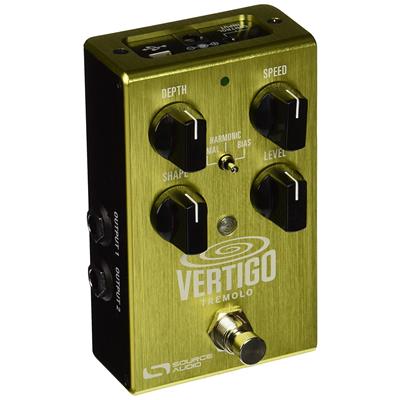 | Source Audio SA243 Vertigo Tremolo Effect Pedal |  (4.9 / 5) (4.9 / 5) | Check on Amazon |
 | Fulltone Supa-Trem Jr Tremolo Pedal |  (4.8 / 5) (4.8 / 5) | Check on Amazon |
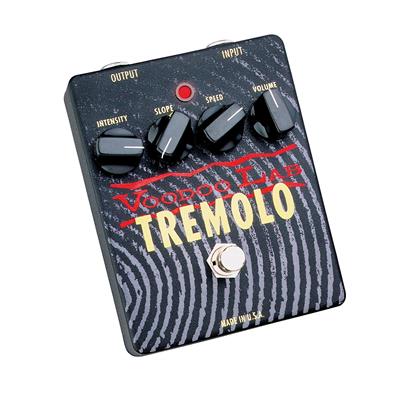 | Voodoo Lab Tremolo |  (4.8 / 5) (4.8 / 5) | Check on Amazon |
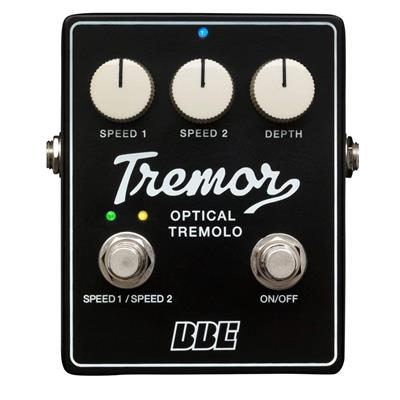 | BBE Tremor Dual-Mode Analog Tremolo |  (4.8 / 5) (4.8 / 5) | Check on Amazon |
 | BOSS AUDIO TR2 Tremolo Pedal |  (4.8 / 5) (4.8 / 5) | Check on Amazon |
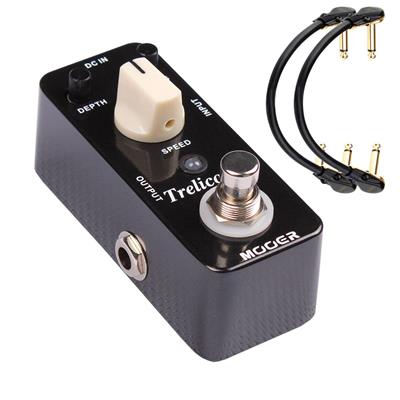 | Mooer Trelicopter tremolo pedal |  (4.7 / 5) (4.7 / 5) | Check on Amazon |
 | Fender Tre-Verb Tremolo/Reverb Pedal |  (4.7 / 5) (4.7 / 5) | Check on Amazon |
Wampler Latitude Tremolo Deluxe Guitar Effects Pedal

Wampler Latitude provides all the control you need. It comes with seven knobs, each of them shaping your sound in a unique way. Let’s begin with rudimentary concepts: Speed and Depth adjust the frequency and the depth of the volume dips. As we go further, things get more and more interesting: you can modify the distance between volume bursts by tweaking the Space control; you can even alter the amount of attack the effect adds to your sound (with the help of Attack knob). The Volume knob makes sure that your efforts are not lost and your tone is heard through anything. To guarantee that all your rhythms are synced perfectly, Latitude offers Tap Tempo and several time divisions (quarter notes, eighth notes, dotted eighth notes, and triplets). There is more: with this pedal, you can choose between different waveforms (peak, sine, square). All in all, Latitude lets you control every single sonic feature and delivers powerful, versatile tremolo effect.
Pros:
- Full control over your tone
- Versatile
- Handmade (for those boutique pedal lovers)
- Defined tremolo effect
Cons:
- A bit hard to understand all the controls
- No battery option
Diamond Pedals Tremolo

Diamond Pedals Tremolo is yet another boutique pedal, which is equipped with analog circuit. It strives to deliver vintage tremolo effect, adding a touch of uniqueness to your sound. At first glance, the controls it offers are quite mediocre and typical for so many pedals, but when it comes to the variety of options, this bad boy is hard to compete with. Speed modifies how fast you want your tremolo effect to be, while Depth adjusts the intensity of volume dips. The Volume knob is your standard level control. The true versatility steps into the game with Mode. It allows you to switch between Rhythmic and Chaotic (random speeds with different waveforms) styles, that add a lot of character to your music. Diamond Pedals Tremolo also lets you set the timing accents according to your preferences and pick out the waveform (sharkfin, sine, square, ‘chop’) that suits your sound the most. This pedal offers jaw-dropping amount of control and lets you craft the tremolo of your dreams.
Pros:
- Extremely versatile
- Lets you shape your effect beautifully
- Completely analog
Cons:
- Not for everyone
Catalinbread Antichthon Tone-Generating Fuzz Tremolo Pedal

Catalinbread Antichthon is everything but your standard tremolo pedal. It combines fuzz effect, which creates a unique tone when layered on top of your tremolo (also referred as “fuzzolo”). The feature that really stands out is its capability to be controlled with the volume knob of your instrument. You can set all the controls on the pedal the way you want and adjust the rest by tweaking your guitar’s volume knob. Time, Space and Volume work together in a special way, adjusting the one causes the other to react differently. Antichthon steps up its game with Gravity knob. It is quite hard to explain what it does, you definitely have to plug it in and listen to the sound to appreciate the greatness of this control. It acts as a tone generator and reacts beautifully to your instrument’s volume knob. The sonic possibilities this pedal offers are out of this world. It can deliver anything from animal cries to extreme fuzzolo to clean fuzz. Antichthon lets all your musical fantasies come to reality.
Pros:
- Extremely unique
- Wide range of sonic possibilities
- Leaves room for classic approach as well
Cons:
- Finding your perfect adjustments is a bit time-consuming
- Labels are hard to read
Source Audio SA243 Vertigo Tremolo Effect Pedal

Source Audio Vertigo is a simple pedal with straight-forward controls, but it can turn into a versatile beast in a blink of an eye. First, let’s talk about the features that are implemented into the pedal itself: it has Rate, Depth and Waveform (square, sine, sawtooth) controls, that allow you to control various parameters of the effect. Additionally, Vertigo has a Volume knob, which sets the level of the effect. This pedal sounds like an amp and in order to achieve this result, it has three modes: Normal, Harmonic and Bias. These let you explore an array of sonic possibilities from vintage to phasy or modern ping-pong tremolo. Vertigo lets you dive deeper: if you connect the pedal to Neuro app, you will step into the world of versatility, effects and adjustments. It definitely has something for everyone.
Pros:
- Easy to use
- Vast amount of effects (with the help of the app)
- Variable tremolo styles
Cons:
- It does not have a battery option
Fulltone Supa-Trem Jr Tremolo Pedal
| Features: |  |
| Controls: |  |
| Sound: |  |
| Value: |  |
| Average: |  |

Fulltone Supa-Trem ST-1 was introduced for the first time back in 1996. It has occupied the hearts of countless guitarists ever since and has been the main player in many prominent rigs, as well. Though we all loved it, there were several downsides that we’d wished were better. The brand listened and manufactured a unit that has everything the previous version lacked. Their Supa-Trem Jr has all the necessary features that are needed to create a versatile, dimensional and powerful tremolo. Just like the ST-1, it’s based on the analog JFET circuitry and Opto-1 Photocell. These properties are what defines its distinctive character and turns it into an indispensable pedal. Supa-Trem Jr has a tap tempo and the ability to choose between half and double speeds. Its slowest rate is so slow that you’ll feel like it’s sweeping through the universe itself, while the fast settings will yield rhythmic parts. This puppy comes with three wave-forms: Square, Sine and Warble. And the best part is that it offers up to 15dB of boost. This way you can retire your boost pedals and use this one instead. As you can see, Supa-Trem is packed with cool and interesting features.
Pros:
- Extremely versatile
- Powerful sound
- Has all the essential features
Cons:
- Not for those who are looking for a one-button tremolo
Voodoo Lab Tremolo

Voodoo Lab Tremolo offers a perfect balance between cool features and classics. It is equipped with lamp and photocell circuits, which deliver your perfect tremolo. The controls on this bad boy are quite typical: Depth adjusts the amount of the effect added to your sound, Slope lets you switch between vintage and modern styles, Speed does exactly what its name indicates, while Volume enhances/decreases the level of the overall output. When it comes to the performance, Voodoo Lab Tremolo gives you the option to dive in nostalgia and explore sounds from good old days. The tone it produces could be labelled as smooth and warm. If you are looking for a tremolo pedal that simply does its job without overcomplicating features, this one will be a goldmine for you.
Pros:
- True bypass
- Vintage tones
- Simple to adjust
Cons:
- A bit hard to place on the pedal board
BBE Tremor Dual-Mode Analog Tremolo

BBE Tremor consists of military-grade circuitry, which strives to deliver ‘60s Fender-like sound. It works really well with rock, garage or surf. This pedal creates a warm, pulsating tremolo, that was produced by amps back in the day. BBE Tremor is so easy to control, that you will be able to find your perfect tone in no time. Speed 1 and Speed 2 gives you the full control over the speed of your tremolo (it also has foot switchable Speed 1 and Speed 2 modes). Additionally, this pedal has Depth control, which is quite a self-explanatory feature. BBE Tremor is a true bypass, making sure that your tones will not get lost when the pedal is disengaged. This pedal delivers the effect without coloring your sound too much. Simple yet powerful, what else do you need?
Pros:
- All-analog circuit
- Versatile
- Replicates the sound of Fender amps
Cons:
- The capabilities of Depth are a bit limited
BOSS AUDIO TR2 Tremolo Pedal

BOSS is one of those brands, that never fail to create quality products. TR2 is no exception. Its simple features allow you to control your tone at ease and produce very defined tremolo effect. Just like any other boss pedal, this bad boy is also built like a tank and will last you through a lifetime. With that out of the way, let’s get back to the controls. BOSS did not want to turn the world upside down with overcomplicated knobs, but rather concentrated on the quality of sound and easy adjustment. Thus, you can control the speed of the effect and the depth of volume dips with Rate and Depth controls. Wave allows you to alter the waveforms and go from triangle to square waves. All of these factors result in quality performance and a sound that will astound many listeners. TR-2 is a case, where simplicity is everything you need.
Pros:
- Indestructible
- Great tone quality
- Vintage sound
- Easy to adjust
Cons:
- A bit expensive for the features it offers
Mooer Trelicopter tremolo pedal

Mooer Trelicopter is one of the most affordable tremolo pedals on the market. It allows you to deliver desirable sound without the need to break the bank. Featured in a compact design, Trelicopter is quite easy to tweak and adjust. With the Bias knob, you can add color to your tones and modify the waveform. Speed and Depth allow you to control labeled parameters, which makes your tremolo more precise and rhythmical. The sound of Trelicopter is very natural and soft. Apart from good performance and affordable price, this pedal is from micro series, which means it will save up a lot of space on your pedal board. Plus, it has a full metal body, making it quite durable and long-lasting. This guy is a great bang for the buck.
Pros:
- Compact design
- Well-built
- Responsive controls
Cons:
- Depth and Bias are hard to see
- Does not have level control
Fender Tre-Verb Tremolo/Reverb Pedal
| Features: |  |
| Controls: |  |
| Sound: |  |
| Value: |  |
| Average: |  |

Though Fender is relatively new to the pedal market, they’ve already proven that they maintain high quality with these units as well. Not that it was surprising, but we should always appreciate the things that deserve appraisal. Now we’re talking about their Tre-Verb – a stompbox that combines tremolo and reverb effects and, consequently, provides us with interesting features to work with. They have individual footswitches and the layout will make you think that Fender joined two separate units in a single body. Yet you’ll have the feeling that you’re dealing with one powerful pedal throughout the whole journey. Tre-Verb offers three different voicings for each effect to make sure we have the choices we desire. Though some of you might have the feeling that this pedal could have been more versatile, let’s face it, it does have all the essential properties and quite a bit of diversity. The sound has an amazing quality and could easily be utilized for recording. Its durable construction means that it will stay with you for a really long time. Wonderful job, Fender!
Pros:
- Offers the combination of tremolo and reverb
- Tap tempo
- Beautiful design and durable body
Cons:
- A bit pricey
- Not as versatile as we’d prefer
What is tremolo and how is it different from vibrato?
The music industry remembers many misunderstandings that happened due to inadvertent actions of companies or people. Things that start of as simple mistakes sometimes result in prolonged consequences. The case with tremolo and vibrato is no exception. Even big companies are guilty of confusing the two, misleading their customers. For example, in 1954 Fender brought to life the Stratocaster guitar. It featured mechanical bridge mechanism that was supposed to create certain movement (swooping effect) by allowing for string bends. This was a vibrato system at core, however, Fender promulgated it as synchronized tremolo system. Until this day many people still refer to those systems as tremolos. With that being said, I can’t help but wonder, what is the big deal and how are those two effects different from each other. I will provide the definition and technicality of both side by side, which will help us put an end to this nonsensical misunderstanding.
Tremolo is a modulation effect that relies on the fluctuation of volume or amplitude in the sound wave. This creates a pulsating signal, which can be described as “trembling” or “shuddering”. Vibrato, on the other hand, creates modulation by shifting the pitch of the audio signal. This creates a sense of movement, dynamics and rhythm, which add thickness to your sound. Even though the difference between the two might seem too slight to be important, when it comes to performance and overall tone, the distinction between them gets more noticeable. If you are looking for rhythm and notion in your sound, definitely go for vibrato – tremolo enables you to create more dramatic effect such as staccato stuttering.
Now that we have discussed the significant details that more or less have an effect on our music, we can move on to briefly addressing how tremolo pedals work, different waveforms and what should the best tremolo pedal have.
How does a tremolo pedal work?
Since the most essential part of creating the tremolo is altering the level of the signal without interfering with pitch, tremolo pedals require a circuit, which will allow for frequency fluctuation. It will react to the volume of the signal and produce the sound accordingly. You can adjust different parameters of your tones with Rate/Speed and Depth knobs, typical to almost every tremolo pedal. They let you set the amount of effect while adjusting the depth of volume dips. This means that you can create highest and lowest margins for your frequencies.
When you switch on the pedal, it’s circuitry starts producing a wave carrier signal, which tends to vary the amplitude of your dry signal. To put it more simply, the initial volume of the tone will decrease to its minimum and then intensify again. This is exactly how a wave is created. Depending on the features of the pedal, you can form sine, square, peak and many other waveforms (we will talk about this in depth below). Some pedals offer merely certain types of waves, while others provide you with the option of choosing between them.
Nowadays, there are multiple circuits that can create a tremolo effect. One of them depends on Voltage Controlled Amplifier. This lets the pedal modify the amplitude of the sound wave resulting in tremolo effect. This circuit operates as easily as it sounds and is quite reliable due to its stable nature. Everything fluctuates in this one except for performance.
Let’s move on to the next one. LFO (Low-Frequency Oscillator) circuit typically consist of high and low pass filters. It alters the phase of the signal and delivers amp-ready sound at the end of the chain. This alteration creates a tremolo effect. Many handmade pedals use LFO circuits that operate with photocell, meaning that the sound signal passes through a bulb, which causes other parts of the circuit to react. The wave you get out of this one is quite square.
In my book, this information is thorough enough for you to understand the basics of tremolo pedals. Since I want you to grasp your sound to its core, I will now discuss different waveforms and how they affect your sound.
Types of waveforms
Let’s start with the triangle waves. They basically create triangle-shaped forms when fluctuating. This means that when the level of the signal rises and falls, the peaks and lows are very pointy and defined. No matter how soft you play, the nature of triangle waves will always stand out. Such kind of waves slice through the music and create unique effect. To understand this concept more thoroughly, listen to “Crimson and Clover” by Tommy James & The Shondells. You will come across triangle waveforms in BOSS TR-2 and Fulltone Supa-Trem mentioned above.
Sine waves are way subtler. They are created due to the modulation of the transistors or power tubes. They were produced with the help of small combo amps back in the day. The waveform itself is very smooth since the gradation from peaks to lows is gradual without any harsh lines. This results in subtle performance and if you drive them to their limits, it will start resembling square waves.
Speaking of which, the latter is another form of a wave. It creates squares, meaning that the sound can be completely on-off at some point. Square waves create a dramatic effect, resulting in heavy pulsating tremolo. This type of wave is often referred to as ‘chopped’ as well.
You might come across the waves labeled as sawtooth or sharkfin. The sawtooth resembles a triangle wave in a way, but ups and downs occur more frequently and are even more defined. Sharkfin is basically the same thing. Many pedals offer these additional waves in order to give you an array of tremolo effects.
The perfect tremolo pedal
From all the features discussed above, it must be easy to determine which of them are essential. In order to achieve full control over your tone, simple Depth and Speed knobs might not be enough. Let’s discuss in detail what makes a good tremolo pedal.
First things first, though it might seem like a very basic control, the volume knob carries significant responsibility when it comes to tremolo. This effect tends to create an illusion that the level of your overall output is lower than it is in reality. You can easily tackle this problem by turning up the volume control. I am pretty sure you do not want your sound to be inaudible to listeners.
Moving on to waveforms. From the dedicated section above, you understand how much effect these little shapes have on your sound. Having the option of choosing between different waveforms will definitely be an asset when it comes to shaping your tone precisely. This simply makes it easier to achieve the desired effect without any limitations.
Last but not least, tap tempo. As with any other rhythmic effects, tap tempo will save you a lot of headache. This feature will allow you to control the speed of the tremolo with a tap of the footswitch, taking precision to a whole new level. Even though the concept is simple, it will change your game completely.
These are the features that turn a basic tremolo pedal into the best one. This does not mean that the pedals will suck without them. If you take another look at the pedals listed above, you will find that you can still achieve quality performance with simple controls. It all depends on the level of precision you want your sound to have.
Conclusion
To conclude all the things mentioned above, I will say that the best tremolo pedal is the one that complements your music in a unique way. How you play your instrument, what settings you experiment with or the signal chains you create will have a great impact on your overall sound. The mission of a tremolo pedal is to serve you through anything and make your job easier. Tremolo pedals make a statement when it comes to performance and no one can argue with that. All you need to do now is to make a decision, buy your favorite pedal, plug it in and let the music speak for itself.







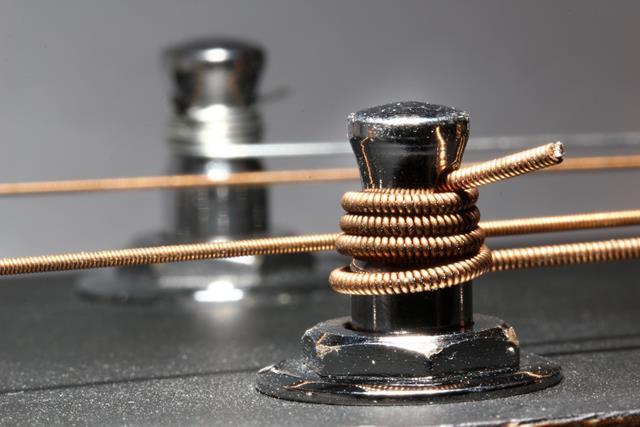
Does anyone know which is the best product among those listed on this site?